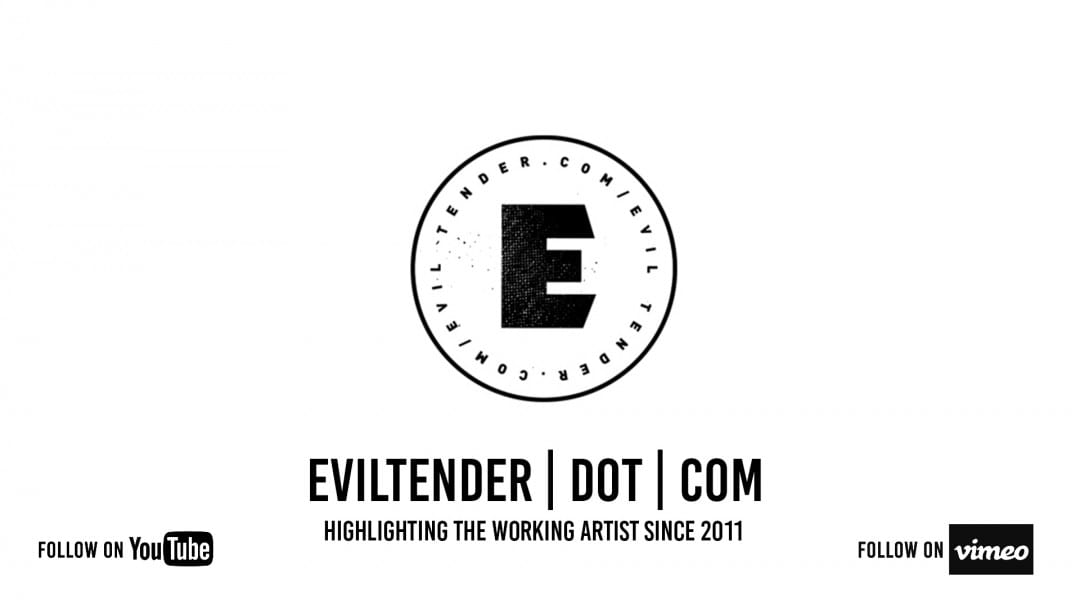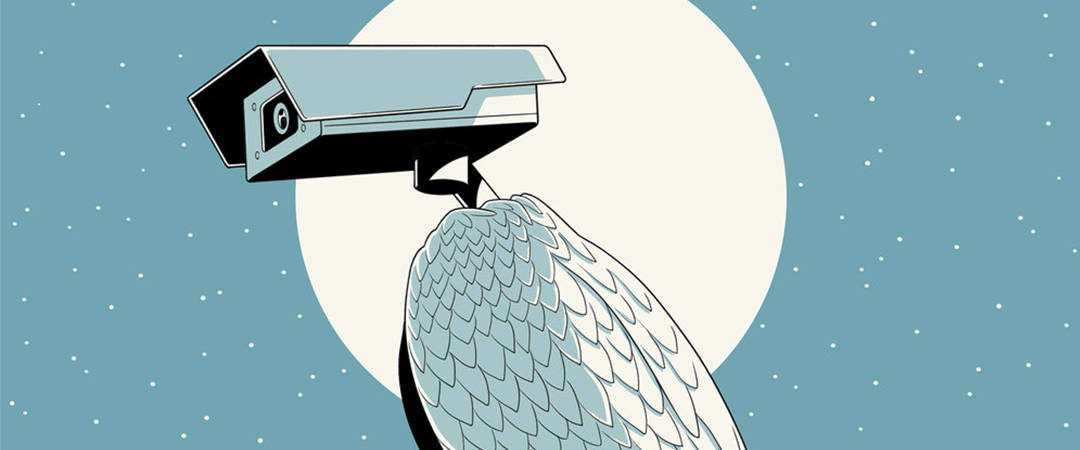
The comics of Philadelphia based illustrator and cartoonist Anuj Shrestha are direct. Clean shots of insight and emotion. Shrestha excels at clearing the murk off of large emotional and social concepts and delivering a solid punch to the gut of the audience. One only needs to see his pieces Ghosts or Simulation to understand the level of clarity in which Shrestha works.
In his comics, he takes on climate change, immigration, terrorism, technology, and the government — each a wordless essay summed up in six panels or less. Shrestha casts no blame and paints no heroes. His take is that of a journalist chronicling his subject as it presented to him. Artist disappears and all that remains is the statement of the work at hand.
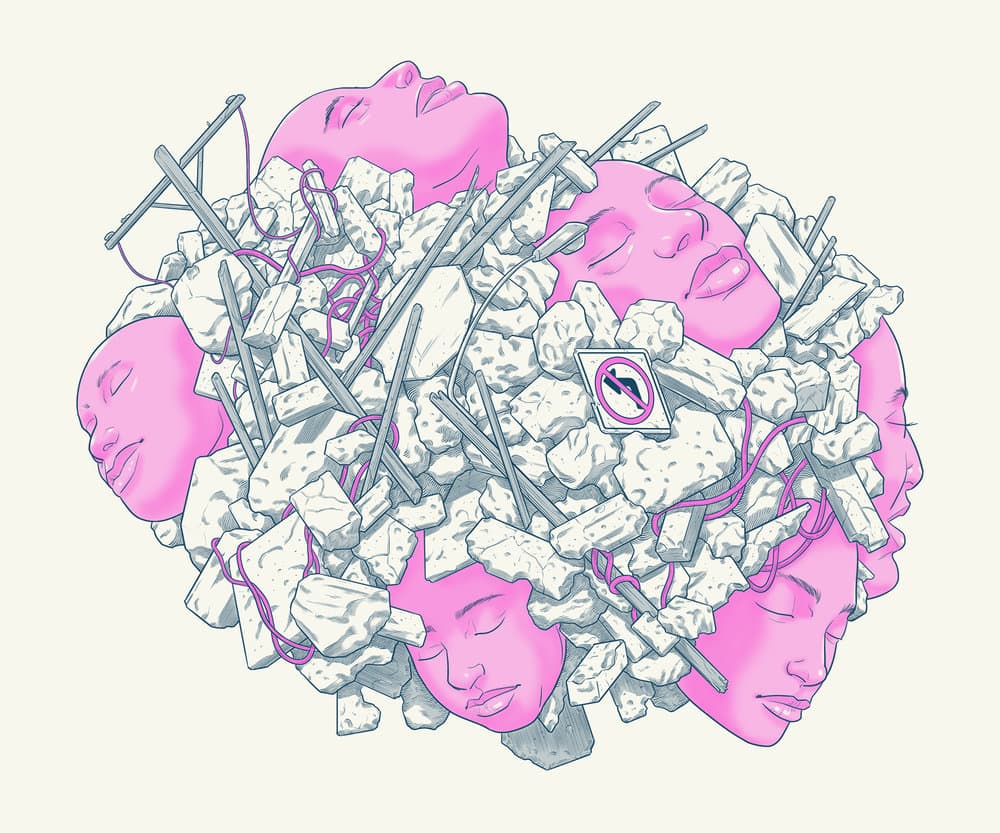
‘Residents’ by Anuj Shrestha
CJ: Early in your career, you worked as a production artist making illustrations for children’s educational software. Was your plan to always move into freelance work? Was there any attraction to the world of in-house illustration work?
AS: After college, I sought out in-house work so I could rely on a steady paycheck to cover living expenses as well as to manage the debt burden of student loans. Securing a job as a production artist allowed me to do that while satisfying my need to draw for a living. At that time freelance work was not something I could even consider as a viable career option.

‘Ghosts’ by Anuj Shrestha
Your style and voice have been present since your earliest work. I recall your work back in the late ‘90s early ‘00s, and the look of what you are doing is as crisp and direct as it ever was. Personally, comics have been of huge assistance (thinking Dan Clowes, Adrian Tomine, Box Brown, etc.) in grounding me in myself, if that makes sense. Showing people and the world as they are and making it personal helped me feel better in the world, which is something your work achieves when looking at current America. Optic Nerve and Eightball showed potential outsiders as real people, better than music or movies can. Have comics, reading and creating, been a part of your personal journey?
I always thought comics were an effective platform to tell stories that had large, impactful ideas while communicating them in a personal manner. I’ve been inspired by the artists you mention in addition to the work of the Hernandez brothers. They tell epic narratives that also feel intimate because of the nuance of their drawings. Using comics feels approachable because you can tell stories using your own vernacular.

‘National Bird’ by Anuj Shrestha
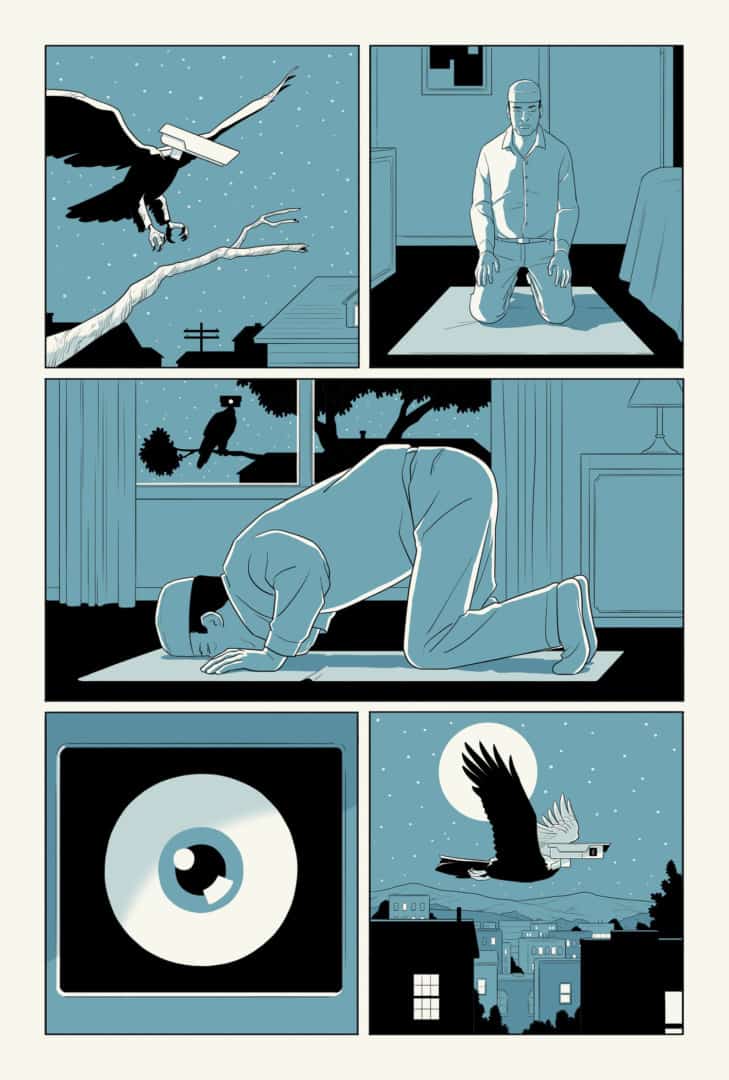
‘National Bird’ (Excerpt) by Anuj Shrestha

‘Countering Terrorism with Racism’ (Excerpt) by Anuj Shrestha and Nazia Kazi
Your comics have an amazing sense of openness; you show “what is” without telling the audience how to feel about it. In National Bird you explore the nature of modern surveillance. You show how society is being watched at all times. Unlike the reality shown in your comic Countering Terrorism with Racism, there are no moments where action is taken because of what the cameras see. The FBI doesn’t infiltrate the school to see what the teacher is teaching, the man in prayer is watched, but not attacked. Are you trying to avoid making a decision for the audience?
I don’t want any of my work to seem didactic even though I hold strong convictions. Specifically, in my fictional work, I think it’s more effective to present ideas and scenarios in clear, concrete ways and let the reader draw their own conclusions. I thought of National Bird as a surreal dream that allegorically connects to real power structures that affect the lived experiences of people living in the U.S. The actions that are not taken (or possibly will be taken) by the characters in the story are not necessarily the focus of the narrative. It is quite a different approach to Countering Terrorism with Racism (a collaborative effort with cultural anthropologist Dr. Nazia Kazi) which was an exercise in comics reportage.
Were you familiar with Dr. Kazi prior to illustrating her article, Countering Terrorism with Racism? It’s a very insightful look at the nature of race, terror, and the idea of a self-policing of culture. You illustrate her article word for word, or moment by moment. It’s a very clear and direct take on her text. What was your process for taking the article to comic form?
Were you working closely with an AD on the correct flow of the piece, or were you left to your own ideas?
Though we worked closely with an editor who provided feedback throughout the sketch/thumbnail phase, we had the freedom to work with our own ideas.
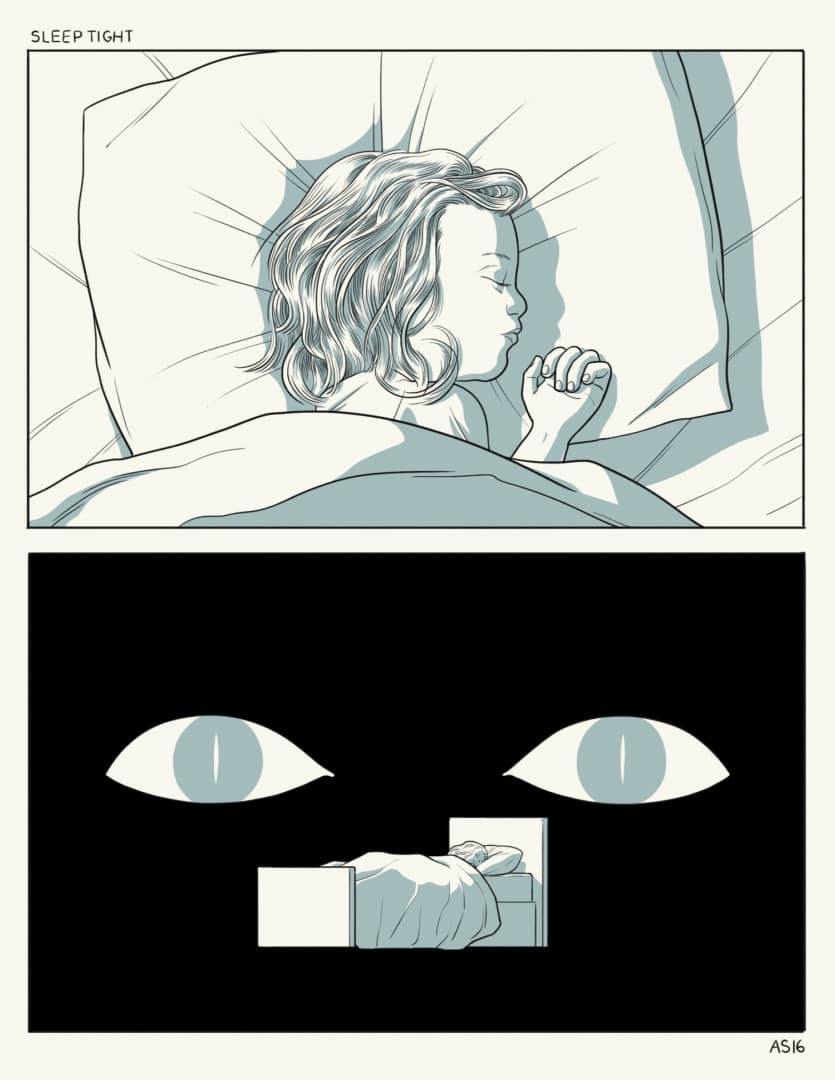
‘Sleep Tight,’ two-panel comic by Anuj Shrestha
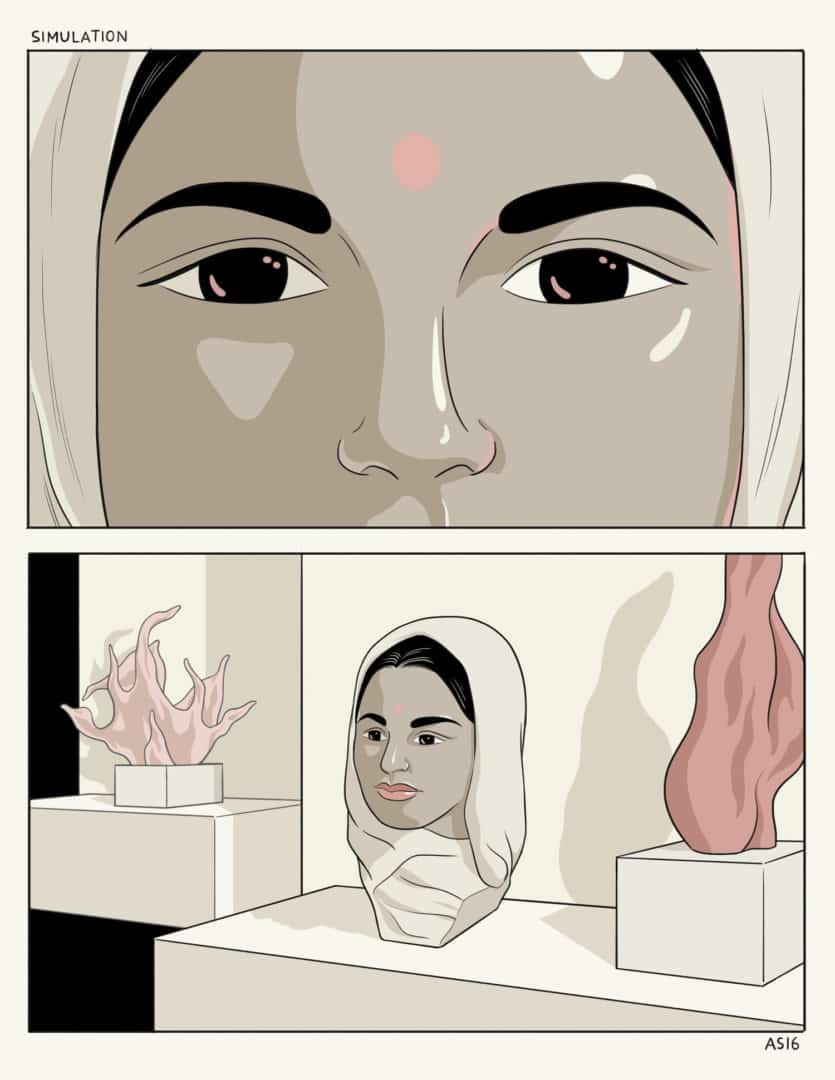
‘Simulation,’ two-panel comic by Anuj Shrestha
Looking at some of your wordless two-panel comics like ‘Sleep Tight’ and ‘Simulation,’ the audience isn’t told anything explicitly – there is no clear message, but you feel what it is your saying. ‘Simulation’ is terrifying in a way, it shows the fetishizing of the foreigner, how parts of a country would want that foreigner to be their art object and not their own person, yet the bindi on her forehead is also the ominous mark of a sniper rifle. When starting a comic, do you begin with a feeling, or a message you want to convey?
I absolutely start with an idea or feeling when creating a comic, whether it’s just a few panels or multiple pages. Usually, the feeling is something visceral and straightforward, such as fear, loss, regret, or even bliss. The power and tension of a comic are usually more effective when the individual can bring their own experience to the narrative.

‘Symptoma’ (Excerpt) by Anuj Shrestha
After creating incredibly successful 2/3/6 panel comics, what do you see when looking back at a comic like 2014’s Symptoma? Is there any desire to wish you had cut anything out? Is a shorter comic better overall, or dependent on the narrative?

An illustration for The New York Times Sketchbook section about our ongoing climate crisis by Anuj Shresthra
In your illustration work, to tend to do more news of the world rather than illustrating a piece of fiction. Was it a conscious choice to focus on politics and societal matters? Does the world of pop culture hold any appeal to you as an illustrator?
Much of my editorial illustration work is definitely in the service of accentuating a piece of reportage. I am drawn to politics and ideas of social justice so it’s a more comfortable fit. In terms of pop culture, I love looking at creatively executed fan art of comics, cartoons, film, etc. but I rarely have the motivation to create such work. Also, many people are already doing it in more effective ways.
Hear No Evil has a classic alternative comic vibe to it. It’s in league with Harvey Pekar, Dan Clowes, and Adrian Tomine in its everyday nature, yet it doesn’t have the personal story feel of those creators. It covers gentrification, the class system, shame, and humanity – all of that without explicitly saying anything positive or negative about it. In Hear No Evil you take those topics and show how both sides are right. You look outside of yourself and show the darkness, the gray areas, of America. Are you hoping to enlighten your audience? Enrage?
That’s an interesting interpretation of that piece because I felt I had a more pointed agenda! I’m not sure if I want to necessarily say both sides are right, but I do feel that I have personal culpability in these institutional power dynamics. As a person coming from a space of privilege where I have the ability to move into a gentrifying space, I want to critique the problem while being aware of my own complicity. It’s something all artists should be aware of when creating work that is relevant to issues that exist in political reality.
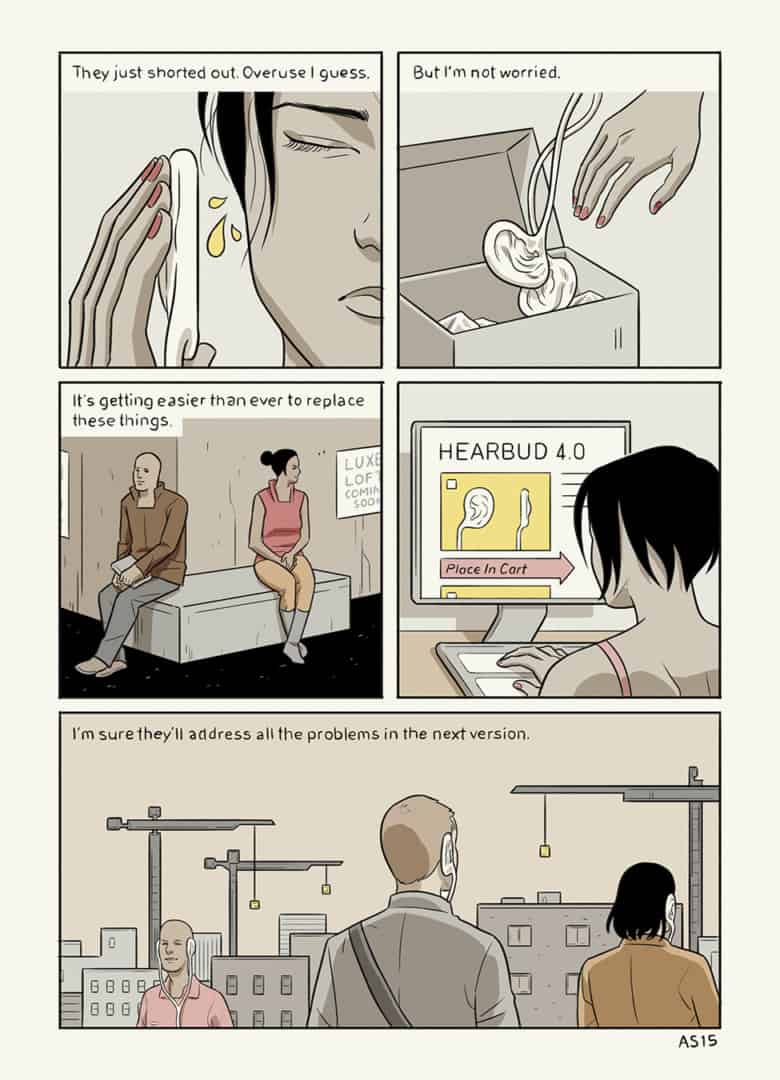
‘Hear No Evil’ by Anuj Shrestha | Originally appeared in Future Shock 0, published by Retrofit Comics.
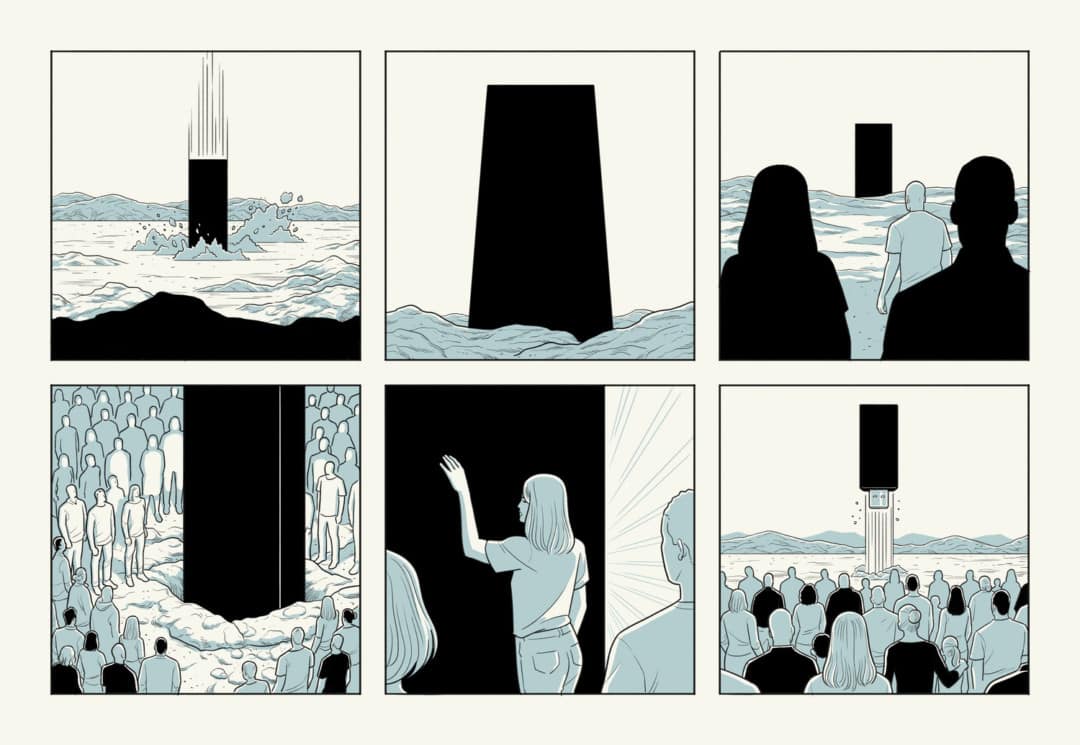
‘Save the Data, Leave the Crew’ by Anuj Shrestha for Wired Magazine’s 6×6 Series
Your work fits perfectly with Wired magazine – there is a shared apprehension and appreciation of technology and the future. How did the 6 Word comics come about? Were you involved in picking the stories you would illustrate?
Back in the fall of 2017, I was contacted by art director Mike Ley when he was still at the magazine. The concept was Wired’s 6 x 6, wherein readers would submit six-word stories or concepts that adhered to a specific call-out by the editors. They would supply me with usually three-story options submitted by various readers and Mike and I would create the concepts for the six-panel comics. It was fun to experiment with vastly different narrative ideas within the restriction of a six-panel grid.






